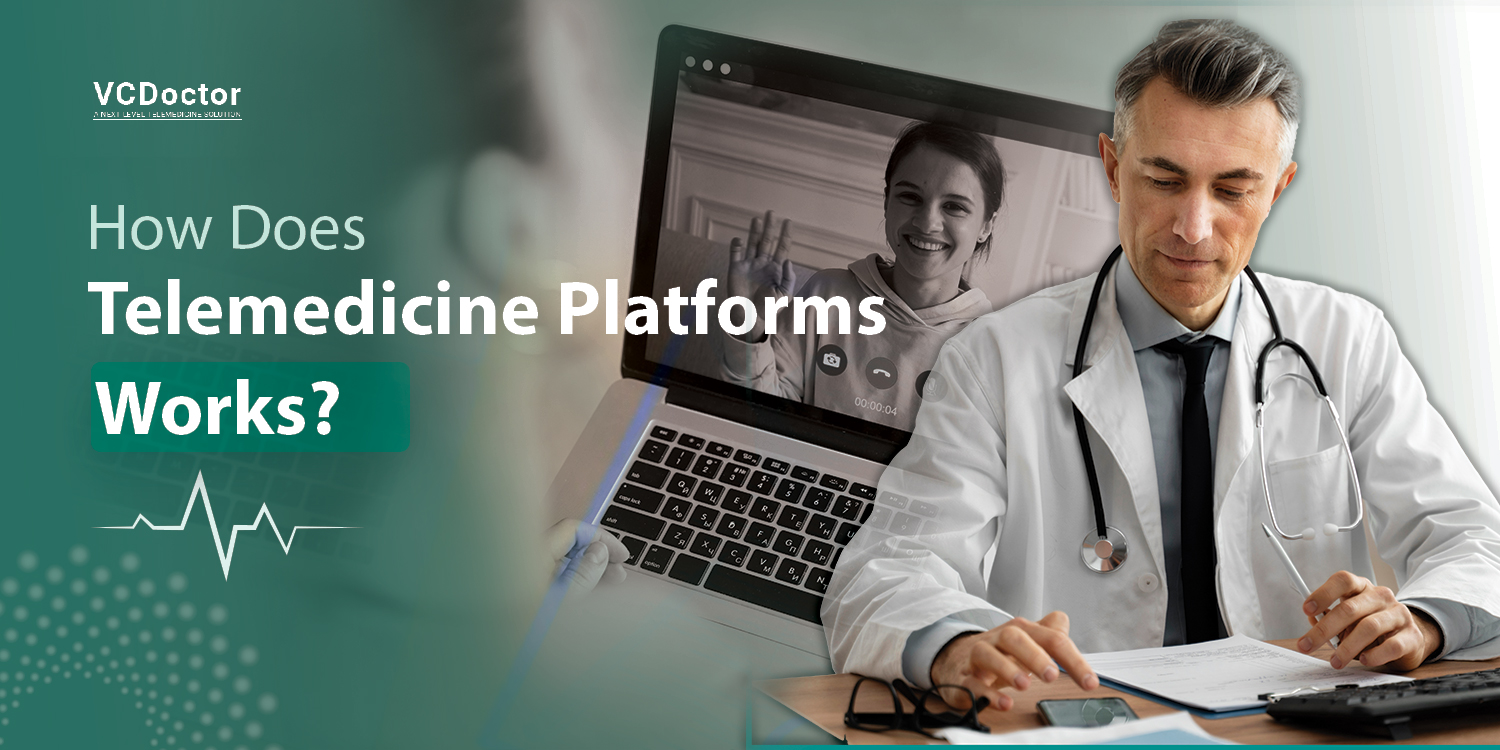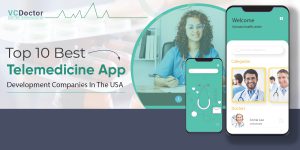How Does Telemedicine Platforms Works?
Telemedicine services has become a vital part of modern healthcare. Nowadays, doctors and patients rely on telemedicine platforms to get access to medical care. Earlier, it was very hectic for the doctor to manage multiple patients at a time. As a result, patients prioritize their health and believe that doctors do not care about their condition. To eliminate this conflict, telemedicine platforms gave leverage to both doctors and patients, where doctors can schedule appointments according to their timeline, and patients can find available doctors at their convenience.
Therefore, let’s explore how telemedicine platforms work for doctors and patients. Moreover, also check all the edited aspects of telemedicine solutions and what are the benefits of using telemedicine platforms.
Table of Contents
- What is Telemedicine Platforms?
- Key Components of a Telemedicine Platforms
- Technologies Behind Telemedicine Platforms
- How does Telemedicine Platforms consultation work?
- Benefits of Telemedicine Platforms
- Challenges and Considerations
- Future Trends in Telemedicine Platforms
- How VCDoctor provide a Telemedicine Platform for Doctors and patient
- Conclusion
- FAQs
What is Telemedicine Platforms?
Telemedicine refers to the practice of using telecommunications technology to deliver medical care and services at a distance. Let’s understand telemedicine with an example. When a patient needs to connect with doctors from another country, it is very inconvenient to search for their profile on Google. In this situation, they can reach out to the telemedicine platform and find the top professionals out there. In the case of doctors, it is very hectic for them to attend to all the patients at the same time, and they can’t manage their personal lives while attending to the patients. So, they need a platform or software that can manage the patient’s appointments and schedule them at their convenience. Concluding, both telemedicine software platforms provide a convenient way to both doctors and patients where they can interact and get necessary medical care.
Key Components of a Telemedicine Platforms
User Interface (UI)
- For Patients: Technologically, a good application should have an interface that enables the patient to book an appointment, view their records, and interact with the provider. This might include websites, applications installed on smartphones and computers, and any other software commonly used in workplaces.
- For Providers: Several interfaces are essential to clinicians and other healthcare professionals, including appointment management, reviewing patient information, consultation, and documenting interactions with patients.
Video Conferencing
Modern, effective, and secure teleconferencing applications are very important for real-time healthcare consultations as it is necessary to follow rules of confidentiality with patients’ records, HIPAA, etc. These tasks are not only effective in terms of establishing good and easily understandable communication between the doctor and the patient but also, in addition to the conversation tools, provide options like screen-sharing, file-sharing, and virtual waiting areas.
Electronic Health Records (EHR)
Integrated electronic health records let providers view and amend information concerning the patient within the consultation, thereby providing care providers with full records like past history, drugs, tests, and more. The provision of the current information contained in the patient’s electronic records makes the quality of care appropriate, hence leading to better patient outcomes and treatment interventions.
Appointment Scheduling
Telemedicine platforms are designed to have proper scheduling facilities through which appointments can be made online. In addition to reminding patients and handling cancellations, these systems also synchronize with the providers’ schedules. This integration also guarantees that the patients time is well utilized and that there is better management of the healthcare providers’ time, hence minimally wasted time as a result of canceled appointments.
Remote Monitoring
Wearable health monitors, blood pressure cuffs, and glucose meters send patients’ data to healthcare providers in real time. This remote monitoring is useful in the management of chronic diseases like diabetes, hypertension, and cardiac diseases, enabling providers to have patients’ health information at a glance and make appropriate and timely interventions based on the trend.
Secure Messaging
Telecommunications is an effective tool for delivering healthcare. It is effective in interstate communication and other remote practices; one of its key components is the ability to secure messaging. This tool supports one-on-one, synchronous communication through which patients can follow up, request refills on prescriptions, and report test results when they deem appropriate. Encryption helps to keep the data safe and maintain patient confidentiality in keeping with healthcare industry acts such as HIPAA.
Billing and Payment Processing
Telemedicine billing systems are advanced systems that manage the payment procedures electronically for both patients and providers. Patients pay for services through the Internet, while providers sort out issues related to insurance claims and billing records. The three sources of transparency also result in better self-satisfaction among patients since they reduce the level of complexity experienced through the payment procedures.
Technologies Behind Telemedicine Platforms
Cloud Computing
Cloud computing offers the best telemedicine platforms a source of scaling up, flexibility, and cost reduction. They help store and organize large amounts of data safely, which is essential for patients’ records and telemedicine. Such a framework guarantees the possibility of using telemedicine regardless of the connection to the internet, providing an efficient and effective means of preserving and delivering care in various areas.
AI and ML
Machine learning is one of the significant elements in the telemedicine process as it is used to analyze patients’ data for the sake of providing recommendations, prognosis, and diagnosis. For example, by analyzing a diagnosis of a patient, it can recognize any other signs that can be related to certain diseases and give better diagnosis results. Also, with the help of AI, such as chatbots, basic questions can be addressed, and patients can be sorted out before they consult a healthcare provider, increasing the overall effectiveness and the quality of patient care in the telehealth application.
Internet of Things (IoT)
Smart wearable devices such as smartwatches and fitness trackers monitor health data and send it in real-time, which can be easily incorporated into telemedicine solutions. It also allows patients’ status to be monitored constantly and helps to improve the possibility to perform individualized care and prevent ailments early. IoT technology in health care can assist in reducing the time and effort of health care providers to keep track of a patient’s status or progression, thus improving patient satisfaction and outcome.
Data Encryption and Security
The security of data is paramount in telemedicine, and the highest form of encryption is used in the transfer and storage of patients’ records. Following healthcare regulatory requirements, for example, HIPAA in the USA is crucial in enabling patients’ faith in the practice while denouncing legal repercussions. These measures guarantee that an individual’s health information and data are protected and have not been disclosed to the wrong individuals to safeguard the further telemedicine services and the overall confidence of the patients to seek remote healthcare services.
Application Programming Interfaces (APIs)
APIs enable smooth integration between the different software systems involved in telemedicine practice. They allow EHRs, payment systems, and other third-party services to be linked to the telemedicine platforms, hence increasing the roles of telemedicine systems. Through this integration, the flow of activities becomes more coherent. It sets a high standard of user satisfaction through enhanced data transmission and provides holistic healthcare services based on integrated systems.
How does Telemedicine Platforms consultation work?
Scheduling an Appointment
Patients connect to the telemedicine service through a website or an application they download. They look for health facilities based on certain aspects, such as specialty and opening hours. Once they select a provider, they select a time slot and fix the appointment. They receive confirmation and reminders through email or short message service text.
Preparing for the Consultation
Patients’ data may consist of answers to questionnaires that the patient had to complete prior to the appointment, medical records, photos, or documents needed for the appointment. These details are helpful to healthcare providers in preparing.
Joining the Consultation
During the agreed-upon time, the patient and provider join the online video conference. Virtual waiting rooms may be used. The quality of video and audio is also checked to prevent inconvenience during the process.
Conducting the Consultation
In the video consultation, the provider can determine symptoms and speak to the patient about their health history; a visual assessment may also take place, such as when the next item on the list is to share the screen. It helps explain the diagnosis and treatment procedure.
Documentation and Follow-Up
During the consultation, the provider enters visit details and the treatment plan into the EHR. Patients may be given instructions, some prescriptions, or referred to other health care professionals. They can also map out a follow-up appointment.
Billing and Payment
The staff creates an invoice for the consultation, which is given to the patient or their insurance. The website also offers customers secure methods of payment. Hospitals and caregivers deal with bills and insurance through the app.
Benefits of Telemedicine Platforms
- Increased Access to Care: Telemedicine eliminates geographical barriers and enables patients in areas with poor health access. This is especially advantageous, particularly those people who are crippled or those people with no time to go around because of their working or business schedules.
- Improved Patient Outcomes: Teleconsultations make it easier for ill patients and those with chronic diseases to be diagnosed and managed early; hence, this enhances the results. It is easier to encourage people to adhere to a certain plan of treatment if it is easy to have a follow-up.
- Cost Savings: Less traveling and time spent at appointments are cost savings for patients and the delivery of health services. This assists providers in scheduling while reducing the costs incurred in the office.
- Enhanced Patient Engagement: Telemedicine platforms enable patients to retrieve their health information and interact with their providers, thus increasing their participation in the healthcare process. They also utilize educational resources to manage their health status.
Challenges and Considerations
- Technical Issues: Good internet is really important for telemedicine to work well. However, it can be difficult to make different devices and systems work together.
- Data Security and Privacy: It is crucial to keep patient information safe. Platforms need strong security and must follow rules like HIPAA to keep data private.
- Regulatory Compliance: Completing all the rules for telemedicine can be complicated. Providers must follow laws to avoid legal problems.
- Integration with Existing Systems: Connecting with other healthcare technology, like electronic health records (EHRs), can be expensive. Sharing information easily is important for good patient care.
- Patient and Provider Adoption: Some people need clarification about using new technology or trusting it. Teaching and training can help them see how telemedicine can help.
Future Trends in Telemedicine Platforms
- Expansion of Services: Telemedicine will grow into new areas like mental health and managing long-term health conditions. Specialized platforms will make remote care better.
- Advancements in AI and ML: AI and ML will make diagnoses more accurate and personalized treatment plans. Smart chatbots will help patients and doctors.
- Improved Remote Monitoring: Devices like smartwatches will collect more health data to manage ongoing health issues better. A quick analysis will help doctors act fast.
- Enhanced User Experience: Platforms will be easier to use with features like augmented reality (AR) and virtual reality (VR) for remote check-ups and training.
- Global Expansion: Telemedicine will spread around the world, helping in places where healthcare is harder to get. Making rules the same everywhere will help telemedicine work worldwide.
How VCDoctor provide a Telemedicine Platform for Doctors and patient
VCDoctor is the best telemedicine service that has been purposefully developed to help doctors and patients create a number of creditable, hardly difficult, and potentially beneficial encounters. Similarly, with the help of VCDoctor, healthcare providers can schedule appointments with patients and make use of secure video consultations, which make communications quite accessible. These are self-service features through which patients get the option of setting appointments online, record access, and virtual consultations.
The platform can provide healthcare service provision through such components as real-time communication, the handling of electronic health records, and secure payment processing. As for IT security, VCDoctor follows all the norms of HIPAA compliant telehealth platforms to ensure patients’ data confidentiality. Through the integration of VCDoctor telemedicine tools, the healthcare workforce will have the capability of increasing patients’ rapport, streamlining their business processes, and expanding their market to encompass more patients, which may, in turn, evolve the means through which healthcare is delivered to a larger population.
Looking to Develop Telemedicine Platform like VCDoctor?
Conclusion
Telemedicine platforms are transforming healthcare by enhancing accessibility and convenience through technology. These systems connect patients and healthcare practitioners with modern tools and simple interfaces. It enables people to seek medical advice and treatment from anywhere. Telemedicine is becoming an important part of healthcare. It provides new solutions to a wide range of patient demands. Moreover, it improves the quality of care by allowing for quicker consultations and diagnosis, decreasing the need for in-person visits. This change to digital healthcare not only improves efficiency but also broadens access to medical expertise, helping a diverse spectrum of patients globally.
FAQs
Q1 How does Telemedicine work?
A telemedicine platform connects patients with doctors remotely via video calls or messages.
Q2 How do patients use telemedicine platforms?
Patients register, schedule appointments, and join virtual consultations with doctors using their smartphones or computers.
Q3 How do doctors use telemedicine platforms?
Doctors log in securely, review patient information, conduct video exams, prescribe medications, and discuss treatments remotely.
Q4 Is telemedicine secure?
Yes, platforms use encryption and comply with HIPAA to protect patient privacy and data.
Q5 What are the benefits of telemedicine platforms?
It offers convenience, improves access to healthcare, and reduces costs by enabling quick consultations without travel.





I found this blog very informative. As per my knowledge, Telemedicine is the use of technology that enables remote healthcare (telehealth). Telemedicine is defined as the delivery of healthcare services using telecommunications. Thanks for the fabulous detail information.